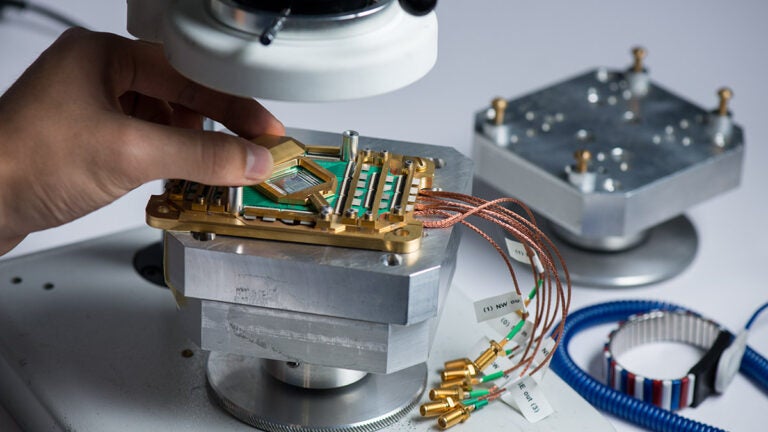
The tiny machinery used in quantum computing has the potential to execute powerful and complicated processes. (Photo/Courtesy D-Wave Systems Inc.)
USC researchers at forefront of quantum computer development
The university is proving the promise of the revolutionary new technology that could solve major challenges in the near future
In the race to build the world’s first fully functional quantum computer, USC scientists report research gains that could make the wonder technology ready to begin solving big challenges in as soon as a few years.
Until now, hype has exceeded performance for quantum computing, yet USC experts testing the new technology report key gains over technical obstacles. They are trailblazing revolutionary technology and gaining confidence it can deliver results. It’s painstaking work proving next-generation technology that business and government leaders say could have a big impact on society.
The ultimate disruptive technology, it has potential to create the best possible investment portfolio, dissolve urban traffic jams and bring drugs to market faster. It can optimize batteries for electric cars, predictions for weather and models for climate change. It can lead to faster delivery of products, lower costs for manufactured goods and best possible travel routes. Quantum computing can do this, and much more, because it can crunch massive data and variables and do it quickly with advantage over classical computers as problems get bigger.
The turning point will occur when the new computers perform immensely complex calculations impossible even for today’s supercomputers.
“We are on the cusp of quantum computing making a difference in real-world applications,” said Daniel Lidar, director of the USC Center for Quantum Information Science and Technology (CQIST), part of the USC Viterbi School of Engineering and the USC Dornsife College of Letters, Arts and Sciences. Lidar is a professor of electrical engineering-systems, chemistry and physics at USC, and holds the Viterbi Professorship in Engineering.
Who will achieve ‘quantum supremacy’?
An intense race is underway worldwide as competitors in Europe, China and the United States invest billions to acquire the technology. IBM, Google, Intel and Microsoft are also racing to build quantum computers. Some use different machines and techniques to pioneer the technology. Partners and sponsors include NASA, the National Science Foundation, the Department of Defense and the Department of Energy.
At stake is control over essential enterprises such as medicine, defense, energy, agriculture, aviation and finance. Whoever gets to “quantum supremacy” first will hold immense advantage due to control of critical information.
USC is unique in this race.
Daniel Lidar
“USC is unique in this race,” Lidar said. “It’s the only university in the world with a [D-Wave] quantum system.”
The system at USC, called D-Wave 2X, has 1098 “qubits” — the subatomic workhorses and capacity of quantum computing — a term derived from bytes in a classical computer.
Specifically, it’s a quantum annealing system, excellent for finding optimal solutions among lots of variables. The USC-led team seeks to achieve “quantum enhanced optimization” to make so-called annealers that can solve complex problems not easily solved for classical computers.
Peeking under the hood of the latest quantum computing news
Unlike today’s computers, quantum computers are powerhouses of atomic matter, superconductors with near-mystical powers of performance. They operate via the counterintuitive laws of quantum mechanics.
In one version of a quantum computer is an infinitesimally small world where tiny electrically charged particles — ions — act as qubits that are magnetically balanced in outer-spacelike cold for optimum performance. The qubits can exist in two states at once, a condition called superposition. They can also become “entangled” to behave identically, a process Einstein referred to as “spooky action at a distance.”
These properties, which greatly accelerate certain computations such as breaking secret codes, give quantum computers their analytical muscle.
For example, faced with a difficult problem, today’s computers sometimes operate like machines shooting a tennis ball into a room. The ball will ricochet randomly until it bounces through an exit. Quantum computers operate like a trumpet blasted into the room. The sound wave floods the room, goes through walls and reaches the exit faster.
It works this way, Lidar said, because, according to quantum mechanics, objects can simultaneously behave as tiny particles and waves. That’s what enables quantum computers to rapidly find, say, a needle in a haystack, recognize a face among lots of images or perhaps one day optimize a stock portfolio.
Research at two centers
USC research occurs at two centers: CQIST and the USC Lockheed Martin Quantum Computation Center (QCC). The U.S. Intelligence Advanced Research Projects Activity selected USC to lead a consortium of universities and funded a multimillion research effort. While the USC-led team, headed by Lidar, has proven the technology works in limited tests and theoretical scenarios, new experiments show increasing promise for real-world problems of practical interest.
For instance, USC researchers recently demonstrated how a quantum processor could be used as a predictive tool to assess a fundamental process in biology: the binding of gene regulatory proteins to the genome. It’s one of the first documented examples in which a quantum processor has been applied to real biological data. The findings were published in the Nature partner journal Quantum Information last month.
Also, researchers from Caltech and USC showed the first successful application of quantum computing to boost machine learning, an artificial intelligence method. They used the technology to train artificial intelligence to help physicists look for patterns. They made machine learning more accurate by separating noise from data to confirm the appearance of rare Higgs bosons, the previously discovered so-called “God particle,” in ultrahigh energy collisions. The USC and Caltech research was published in Nature last year.
As time goes on, and the computers become bigger and more reliable, they will start having a wider impact.
Todd Brun
“As time goes on, and the computers become bigger and more reliable, they will start having a wider impact. The proverbial guy on the street may not be aware of it, but more and more things he uses and does will be touched by quantum technology behind the scenes,” said Todd Brun, professor of electrical engineering at USC Viterbi and deputy director at CQIST.
Progress grows, despite challenges
These successes might seem like baby steps, but they show how quantum computing is moving out of theory and into use. At USC, research focuses broadly on two areas: first, how the technology works, its strengths and weaknesses, and ways to make it more efficient; and second, how the technology can be harnessed to solve problems in real-world applications. Scientists run trials between the quantum computer and classical computers to see where advantages lie.
About a dozen researchers across disciplines such as electrical engineering, physics, chemistry and computer science lead the quantum computing research at USC. They partner with teams around the globe. The QCC is hosted at USC’s Information Sciences Institute in Marina del Rey.
Progress on quantum computing is difficult. The technique is fragile. It must be operated at minus 470 Fahrenheit to keep the quantum effects alive. Computing is vulnerable to upset by noise, tremors and light.
Eli Levenson-Falk, assistant professor of physics at USC Dornsife, said three main challenges must be overcome to achieve a fully functional quantum computer:
- First, maintain “coherence” so processing remains stable long enough to complete a task. Today, lack of coherence limits complexity of tasks.
- Second, improve “fidelity” so that researchers are sure the operation did what it was intended to do. They are working on achieving near-perfect reliability.
- Third, to scale up the technology, they need to maintain coherence and fidelity as processing power increases. They seek to achieve a device that’s reasonably compact and doesn’t needs billions of dollars in control electronics as it adds qubits and scales up.
So how long until those challenges are solved? “I would wager three to five years for some specialized, but important, applications,” Levenson-Falk said. “We’re right on the verge of having quantum processors that are faster than regular computers at solving a few specific problems, so it could happen this year, but more generally useful problems could be solved in the next five years.”
VIDEO Learn more about the quirky properties of quantum computers:



